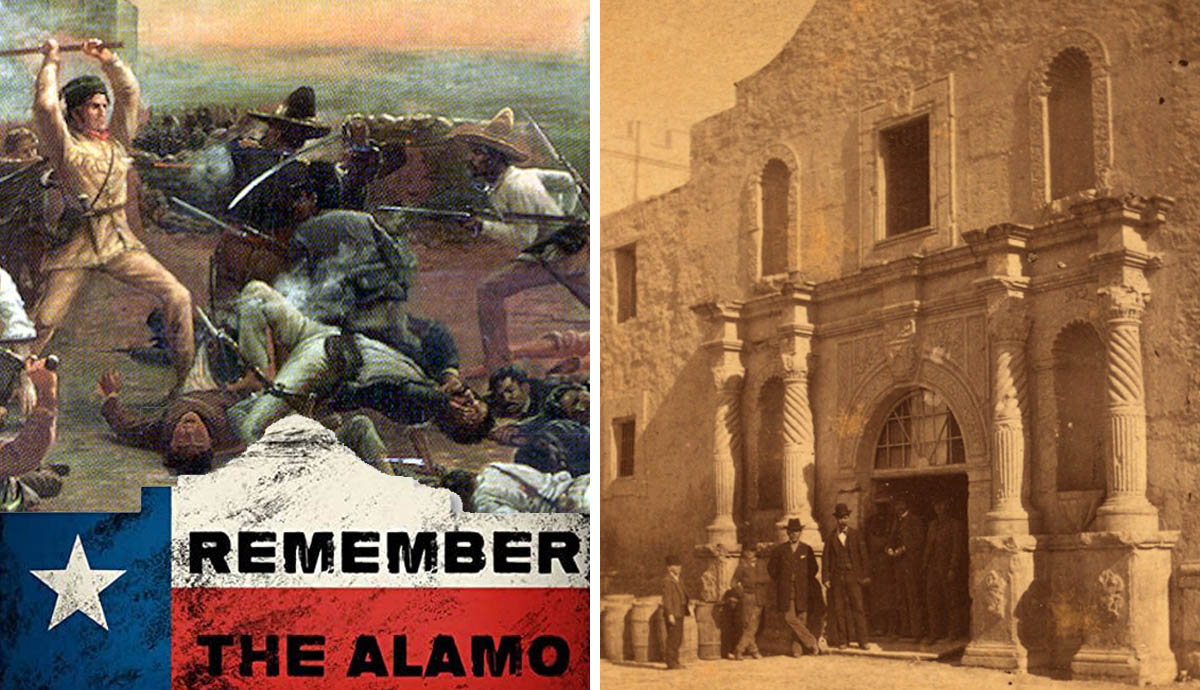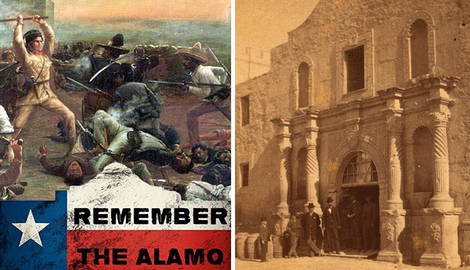
The Battle of the Alamo was a battle for Texas independence, wherein Texas sought autonomy and land from Mexico. The Alamo is in San Antonio, with only some initial structures still standing today. February 23 through March 6 commemorates this 13-day siege at the Alamo Mission in Texas. The siege is the most iconic battle in Texas history, with early-settler Texians fighting ruthlessly against Santa Anna and the Mexican Army. Eventually, the President General of the Mexican Army, Santa Anna, defeated the Texians, but this inspired thousands of Texians to participate in the revolutionary fight for Texas independence. The battle is remembered with the commemorative slogan, “Remember the Alamo!”
Constructing & Fortifying the Alamo

The Alamo was built in 1744 as a Spanish mission but was eventually converted to a military outpost by 1803. Texians reconstructed the Alamo, rebuilding walls and equipping it with several weapons. The updated structure made the fort less vulnerable to the Mexican army advances.
Before the battle, the Alamo was fortified by the Texians, Anglo-American residents of Mexican Texas. The Texians carried out many repairs to make the abandoned mission structurally sound. Lieutenant Engineer Green G. Jamison and Colonel Neill reinforced the walls of the structure using a wooden palisade.
In addition to repairing the Alamo, the Texians brought many weapons. Cannons were one of the main defense points of the Texian army, with roughly twenty-one cannons within the Alamo walls.
The Alamo was chosen as a fortification location because it opened lines of communication for the Texians. Located in San Antonio de Bexár, it was an easy access point on the main roads leading into Texas. People entered and exited, relaying information up to the battle point. The proximity even allowed one person to flee during the first attack.
13 Days of Texas Defense at the Alamo
For thirteen days, Texians fought hard to defend the Alamo from President Antonio Lopez de Santa Anna and the Mexican Army.

Although their battle was ultimately a loss, Texians won the war after seeing the unrelenting dedication of patriots like James Bowie, who fought for Texas independence. The loss of the Texas Army inspired thousands of Texians, who gained their independence six weeks later by defeating the Mexican Army at the battle of San Jacinto.
Day 1: The Arrival of Santa Anna
At roughly 1:00 PM on February 23, 1836, Texians spotted President General Antonio Lopez de Santa Anna leading a cavalry unit into San Antonio. By the evening, negotiations had begun between the Texian Army and the President General. Unfortunately, the negotiations were to no avail.
Day 2: The First Full Day
February 24th was the first full day of the Battle at The Alamo. By now, there were 150 Texans ready for battle. Santa Anna surveyed the Alamo fortification throughout the day and then set up several base camps nearby.

At night, Colonel Willian Barret Travis began issuing an appeal for Texian troops. Fortunately, there were no casualties during the day or night. However, James Bowie had fallen ill by the end of the night and was forced to relinquish his command of the Texian army.
William B. Travis wrote one of Texas’s most famous letters. Aside from being a revolutionary turning point in Texas history, Travis’s letter is one of the most famous letters in American history. It began, “To the People of Texas and All Americans in the World,” and continued with a call against the oppressive Mexican army.
Day 3: The First Assault
The Mexican cavalry carried out the first minor assault on the Texians on the morning of February 25.
It consisted of roughly 300 to 400 Mexican cavalry, which eventually withdrew at nightfall. After withdrawing, members of the Mexican cavalry built adobe fortifications nearby and received reinforcements to replace the few casualties they suffered throughout the day.
On the eve of February 25th, Texians realized they were much less organized than the Mexican army. William Travis made a strategic decision to send Lieutenant Jamison to meet General Houston and ask him for more men. For the remainder of the thirteen-day battle, Jamison made several trips pleading for support.
Day 4: Resources Become Thin
February 25 marks the first day during the fight for Texas independence when Texians struggled for resources. Furthermore, dropping temperatures in rural Bexar County made it challenging to find comfort for the many people who fought in the Texas Revolution.

Texians were forced to leave the fortification more frequently, using more resources than the Mexican cavalry, who slept in warm adobes. General Sesma carried out a minor skirmish on their expedition to collect water from the San Antonio River. Luckily for the Texians, there were more Mexican than Texian casualties.
Day 5: Texans Expand Resources
With Texians struggling to occupy resources like water, the observant Mexican army intervened with the water supply by cutting off drainage and access to crucial water sources like the San Antonio River. Not wanting to leave their fortification, the Texians prioritized defending themselves from afar as they solved their resource issues. The Mexican army continued to progress forward while the Texians maintained constant fire on them.
Texians began finding solutions to their drinking water issues in an attempt to hunker down against the oncoming forces. They dug wells to access clean water, eliminating the need to leave the protective walls of The Alamo and attempted to dig trenches. However, this was to no avail.
Day 6: Mexican Army Makes Advancements
By the sixth day, the Mexican army had made visible advancement on The Alamo. The brutal force used was symbolic of Santa Anna’s oppressive rule. The sixty-eight people inside the Alamo continued to defend their fortress despite the malicious intent and looming doom behind Santa Anna’s advancement.
Day 7: Texians Fail to Receive Reinforcements
By the end of the first week, Texians were exhausted by the vigilant efforts of Santa Anna’s army. The army was closer and grew larger, with reinforcements quickly joining without intervention.

While attempting to help the Texians, incoming reinforcements were cut-off by the Mexican army. The lack of support was a significant turning point for the Texians, who were severely outnumbered throughout the entire siege. Despite having more extensive weaponry than their enemies, the Texians could not compare in size to Santa Anna’s army.
Day 8: The Reinforcements Arrive
At roughly three in the morning, 32 men from Gonzales strategically broke through enemy lines and entered the Alamo, joining the forces in the fight for Texas independence. Unfortunately, these were the only people to join in the battle for Texas independence. All others were cut off by Santa Anna’s army, which was stationed on every side of the military fortress.
Day 9:
On the ninth day of the battle, nothing noteworthy happened.
Day 10:
News of reinforcements arrived at the Alamo. Texians were excited and celebratory. Unfortunately, these reinforcements would never arrive. On the other hand, Mexican reinforcements came to assist Santa Anna’s army.
Day 11:
By this point, the Texians were vastly outnumbered. Only a handful of reinforcements had made it through the enemy lines into the Alamo, whereas many Mexican reinforcements continuously replaced any lost soldiers.

In the afternoon, a Mexican woman betrayed the Texians, delivering intel to Santa Anna and telling him that the Alamo walls were weak enough to penetrate. She told him exactly where the army could enter to overtake the Alamo.
Day 12: Santa Anna Plans to Invade
The Mexican army was only 200 yards from the Alamo. In the afternoon of the twelfth day, Santa Anna designed a plan to take the Alamo. While the Mexican army withdrew briefly to discuss their plans for the following day, Travis announced their inevitable defeat. Anyone who wanted to leave could retreat. One man named Louis “Moses” Rose did leave. He was the only person to withdraw from The Alamo. After realizing what he did, Rose attempted to return but died in the process. A poem called “Moses Rose of The Alamo” recalls his cowardly retreat and return to the Alamo.
Day 13: The Defeat of the Alamo
Unfortunately, the thirteenth day defending the Alamo was the noble day of defeat. The Mexicans defeated the two hundred Texians after Santa Anna assembled his army early in the morning and then sent the cavalry to attack at daybreak. The Texians were taken off-guard, and all defenders were killed. After defending themselves for as long as possible, the remaining soldiers barricaded themselves in the church.
After Overtaking the Alamo

However, the Texian’s utter defeat at the Alamo was not a total loss, as it eventually led to a Texian victory at San Jacinto, which should have been an inevitable failure. The Texans attacked the Mexican Army in the middle of the night, taking them off guard. Thus, the Mexican army’s inability to protect itself ultimately led to victory.
The fight for Texas Independence was a long struggle, with the battle at the Alamo lasting thirteen long days. Unfortunately, all the noble soldiers at the Alamo lost their lives in those thirteen days. However, they inspired many Texians to take action and fight for Texas independence. Although the battle cry “Remember the Alamo” alludes to the initial thirteen-day siege, it became popular when Texas battled against Mexico at San Jacinto. After winning the battle of San Jacinto, the veterans rejoiced and shouted the battle cry to remember the lives lost.









